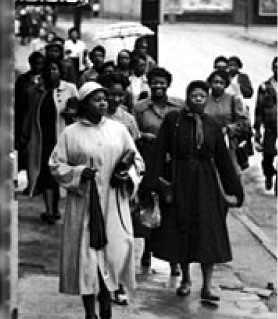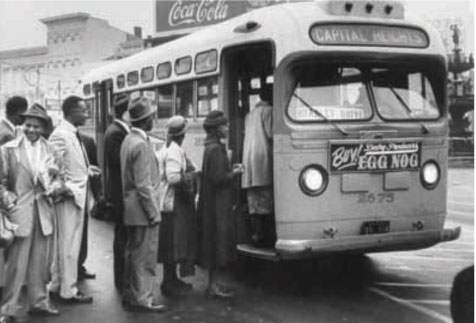Rosa Parks and The Montgomery Bus Boycott
Many have heard a simplified version of the Rosa Parks story, as an isolated incident in which she refused to give up her seat because she was tired, ultimately resulting in bus desegregation. In reality, steps to organize against bus segregation had begun years before, and the boycott was a coordinated effort that involved approximately 40,000 people and over a year of sacrifice
 |
|
|
Walkers during the bus boycott |
There had been numerous instances of Blacks refusing to obey the segregation laws on public transportation throughout the 1940s. The Women’s Political Council (WPC) was formed in 1949, after Jo Ann Gibson was made to leave an almost empty bus for refusing to move to the back . By 1955, the WPC had members in every school, and in federal, state and local jobs, and according to Gibson, its President, “we knew that in a matter of hours, we could corral the whole city”. The WPC had met with the mayor of Montgomery in May of 1954, and followed it up in writing, asking for changes to the bus segregation practices and informing him that if conditions on the busses did not change, citizens would stage a boycott. She stated that with three-fourths of the riders being African American, the busses would not be able to function without their patronage. When conditions did not change, the WPC waited for the right event to serve as the catalyst for the boycott. Three opportunities arose in 1955 when, at different times, a woman was arrested for refusing to give up her seat on a bus to a white person. When, on December 1, Rosa Parks was arrested, the leaders knew the time was right.
Rosa Parks was one of the first women in Montgomery to join the National Association for the Advancement of Colored People (NAACP), and had served as its secretary for years. She had learned about union struggles, had worked to desegregate the local schools and had defied the bus segregation laws in the past.
She had the respect of the community, and the strength to deal with the resultant publicity, pressure and hostility. When she refused to give up her seat in the “colored” section, she acted with full knowledge of what she was doing and the potential consequences.
Community leaders called for a one day bus boycott for December 5, the day of her trial. When the boycott was a success, the leadership formed the Montgomery Improvement Association (MIA). They chose Dr. Martin Luther King Jr., a new member to the community, as their leader. At a mass meeting that evening, it was decided to continue the boycott. Thousands walked or found other means of travel for work, school and shopping, and a system of carpools was created. Drivers and passengers were often ticketed or arrested, and many boycott supporters were threatened with the loss of their jobs and harassed by local government officials.
 |
|
|
For the first time, black passengers board through the front of the bus and sit where they please. |
In 1955, the Federal Interstate Commerce Commission banned segregation on interstate trains and buses. On February 1, 1956, the MIA filed suit in the U.S. District Court challenging the constitutionality of bus segregation in Montgomery. The suit named other Black women, not Rosa Parks, as the plaintiffs. Later that month, over 100 protestors, including Dr. King, were arrested for “hindering” a bus. In June, the court ruled in favor of the MIA, and the city appealed the decision to the U.S. Supreme Court. In mid-November, the Supreme Court affirmed the District Court’s decision that segregation on buses was unconstitutional, and Montgomery buses were finally desegregated on December 20, 1956. The boycott had lasted 381 days.






